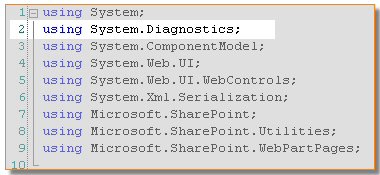
I recently took on the role of maintaining SharePoint Solutions' Resource Portal. Historically, the Resource Portal's content has primarily been in the form of Portal Area Listings. If you haven't visited our Resource Portal recently, please take a look and feel free to send me your comments. It's a work in progress, and I need some help with the artsy stuff.
From a content perspective, I wanted to give the portal a more dynamic "Blog like" look and feel, and roll-up SubArea Listings with RSS syndicated feeds. For performance reasons, I also felt it was important to have controls for caching both the displayed roll-up and the RSS Feed. Although I was able to find freely downloadable solutions that provide RSS syndication of WSS Lists, I couldn't seem to find anything for rolling-up and syndicating Portal Area Listings.

As a result, I went ahead and threw together a little web part to handle the task. An online demonstration of the Area Listings Rollup web part can be found on the home page of our Resource Portal.
The web part has four display styles: Full, Simple, Headlines, and Alphabetical Headlines. The Full style (shown top right) provides the most details, displaying links to the Po
 rtal Listing's parent Area, the Portal Listing author's My Site, and of course the listing itself. The most compact style is Headlines, displaying only links to the Portal Listings. In each of the display styles, an image linking to the Area Listing Rollup's RSS Syndicated feed is diplayed in the bottom left corner (not shown).
rtal Listing's parent Area, the Portal Listing author's My Site, and of course the listing itself. The most compact style is Headlines, displaying only links to the Portal Listings. In each of the display styles, an image linking to the Area Listing Rollup's RSS Syndicated feed is diplayed in the bottom left corner (not shown).
In addition to setting the display style, web part caching is also configurable from the tool pane, and the RSS image link can optionally be hidden from view.
That's about it. You can get the bits for the Area Listings Rollup Web Part here, or from the Downloads Area over on our Resource Portal.
We also have some public community forums at forums.sharepointsolutions.com, and for SharePoint training visit www.sharepointsolutions.com.




